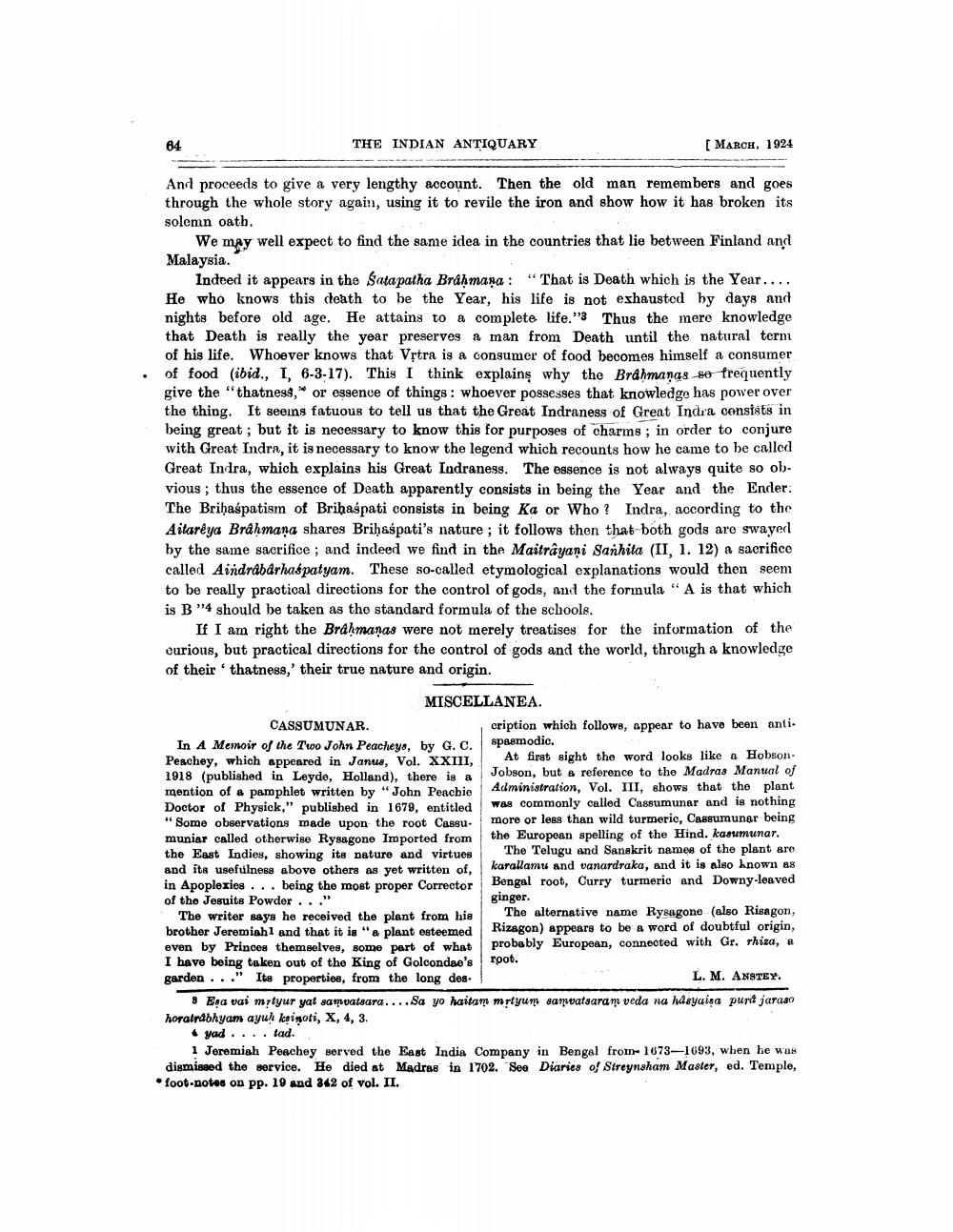________________
64
THE INDIAN ANTIQUARY
And proceeds to give a very lengthy account. Then the old man remembers and goes through the whole story again, using it to revile the iron and show how it has broken its solemn oath.
[ MARCH, 1924
We may well expect to find the same idea in the countries that lie between Finland and Malaysia.
Indeed it appears in the Satapatha Brahmana: "That is Death which is the Year.... He who knows this death to be the Year, his life is not exhausted by days and nights before old age. He attains to a complete life." Thus the mere knowledge that Death is really the year preserves a man from Death until the natural term of his life. Whoever knows that Vṛtra is a consumer of food becomes himself a consumer . of food (ibid., I, 6-3-17). This I think explains why the Brahmanas so frequently give the "thatness, or essence of things: whoever possesses that knowledge has power over the thing. It seems fatuous to tell us that the Great Indraness of Great Indra consists in being great; but it is necessary to know this for purposes of charms; in order to conjure with Great Indra, it is necessary to know the legend which recounts how he came to be called Great Indra, which explains his Great Indraness. The essence is not always quite so obvious; thus the essence of Death apparently consists in being the Year and the Ender. The Brihaspatism of Brihaspati consists in being Ka or Who? Indra, according to the Aitareya Brahmana shares Brihaspati's nature; it follows then that both gods are swayed by the same sacrifice; and indeed we find in the Maitrayani Sanhita (II, 1. 12) a sacrifice called Aindrabârhaspatyam. These so-called etymological explanations would then seem to be really practical directions for the control of gods, and the formula "A is that which is B "4 should be taken as the standard formula of the schools.
If I am right the Brahmanas were not merely treatises for the information of the curious, but practical directions for the control of gods and the world, through a knowledge of their thatness,' their true nature and origin.
MISCELLANEA.
CASSUMUNAR.
In A Memoir of the Two John Peacheys, by G. C. Peachey, which appeared in Janus, Vol. XXIII, 1918 (published in Leyde, Holland), there is a mention of a pamphlet written by "John Peachie Doctor of Physick," published in 1679, entitled "Some observations made upon the root Cassumuniar called otherwise Rysagone Imported from the East Indies, showing its nature and virtues and its usefulness above others as yet written of, in Apoplexies... being the most proper Corrector of the Jesuits Powder..."
The writer says he received the plant from his brother Jeremiah1 and that it is "a plant esteemed even by Princes themselves, some part of what I have being taken out of the King of Golcondae's garden..." Its properties, from the long des.
cription which follows, appear to have been antispasmodic.
At first sight the word looks like a HobsonJobson, but a reference to the Madras Manual of Administration, Vol. III, shows that the plant was commonly called Cassumunar and is nothing more or less than wild turmeric, Cassumunar being the European spelling of the Hind. kasumunar.
The Telugu and Sanskrit names of the plant are karallamu and vanardraka, and it is also known as Bengal root, Curry turmeric and Downy-leaved ginger.
The alternative name Rysagone (also Risagon, Rizagon) appears to be a word of doubtful origin, probably European, connected with Gr. rhiza, a root.
L. M. ANSTEY.
8 Esa vai mṛtyur yat samvatsara....Sa yo haitam mṛtyum samvatsaram veda na husyaisa pura jaraso horatrabhyam ayuh keinoti, X, 4, 3.
yad... tad.
1 Jeremiah Peachey served the East India Company in Bengal from 1673-1693, when he was dismissed the service. He died at Madras in 1702. See Diaries of Streynsham Master, ed. Temple, foot-notes on pp. 19 and 342 of vol. II.




